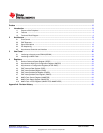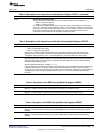
EM_CS[5:2]
EM_OE
EM_RW
EM_WAIT[5:2]
EM_WE
EM_BA[1:0]
EM_D[15:0]
EM_A[22:0]
EMIF
SCR
VICP
DSP
ARM
EDMA3
Master peripherals
www.ti.com
Architecture
1.3 Functional Block Diagram
Figure 1 illustrates the connections between the EMIF and its internal requesters, along with the external
EMIF pins. Section 2.2 contains a description of the entities internal to the device that can send requests
to the EMIF, along with their prioritization. Section 2.3 describes the EMIF's external pins and summarizes
their purpose when interfacing with SDRAM and asynchronous devices.
Figure 1. EMIF Functional Block Diagram
2 Architecture
This section provides details about the architecture and operation of the EMIF.
2.1 Clock Control
The EMIF's internal clock is sourced from the SYSCLK3 clock domain of PLL controller 0 and cannot be
sourced directly from an external input clock. The frequency of the SYSCLK3 clock domain is the PLL0
frequency divided by 4. Changes to the frequency of the input clock to PLL controller 0 and to the PLL
controller 0 multiplier values alters the operating frequency of the EMIF. See the TMS320DM646x DMSoC
ARM Subsystem Reference Guide (SPRUEP9) for more information on how to program the PLL
controller.
2.2 EMIF Requests
Four different sources within the device can make requests to the EMIF. These requests consist of
accesses to asynchronous memory and EMIF memory-mapped registers. Because the EMIF can process
only one request at a time, a high performance switched central resource (SCR) exists to provide
prioritized requests from the different sources to the EMIF. Each requester has a programmable priority
value that may be configured in the System Module MSTPRI0 register or in the EDMACC QUEPRI
register. See the device-specific data manual for more information.
If a request is submitted from two or more sources simultaneously, the SCR will forward the highest
priority request to the EMIF first. Upon completion of a request, the SCR again evaluates the pending
requests and forwards the highest priority pending request to the EMIF.
9
SPRUEQ7C–February 2010 Asynchronous External Memory Interface (EMIF)
Submit Documentation Feedback
Copyright © 2010, Texas Instruments Incorporated


















